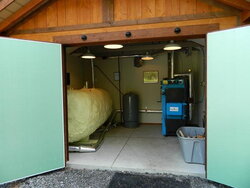Hi all,
Just beginning to understand the world of gasification boilers.
I have a few good options for used units near me - which makes this idea affordable.
A Tarm Solo 30 Plus MKII - with 600 gallon storage tank.
This unit is from 2008.
An Econoburn EBW 150 from 2012 in near mint shape, only used as a backup to oil sporadically, but no tank.
I don't quite fully understand how the storage tanks work relative to the amount of wood used, how long they stay hot, how much energy savings there is, etc... Must do a number on the water bill, no?
Both of these are comparably priced, so which one would I be better off with?
Thanks!
Just beginning to understand the world of gasification boilers.
I have a few good options for used units near me - which makes this idea affordable.
A Tarm Solo 30 Plus MKII - with 600 gallon storage tank.
This unit is from 2008.
An Econoburn EBW 150 from 2012 in near mint shape, only used as a backup to oil sporadically, but no tank.
I don't quite fully understand how the storage tanks work relative to the amount of wood used, how long they stay hot, how much energy savings there is, etc... Must do a number on the water bill, no?
Both of these are comparably priced, so which one would I be better off with?
Thanks!


